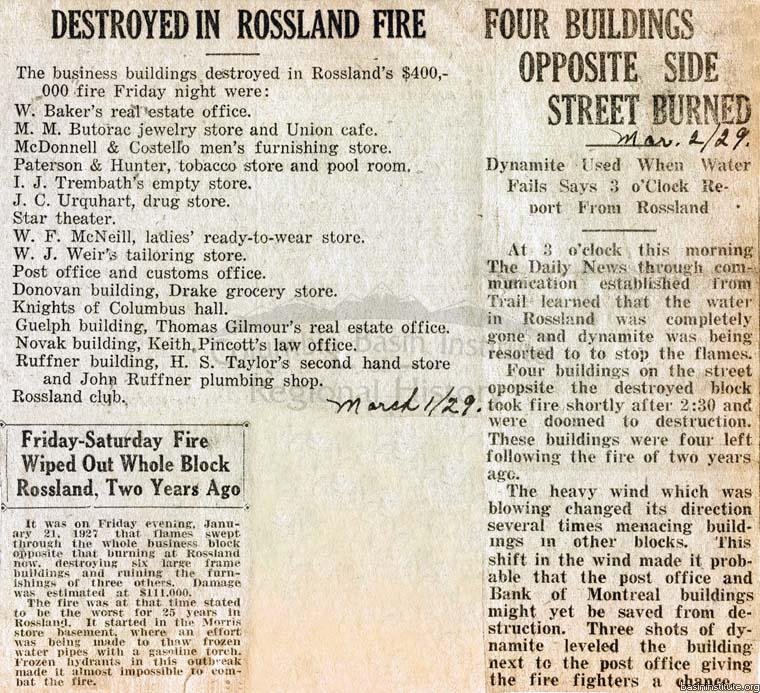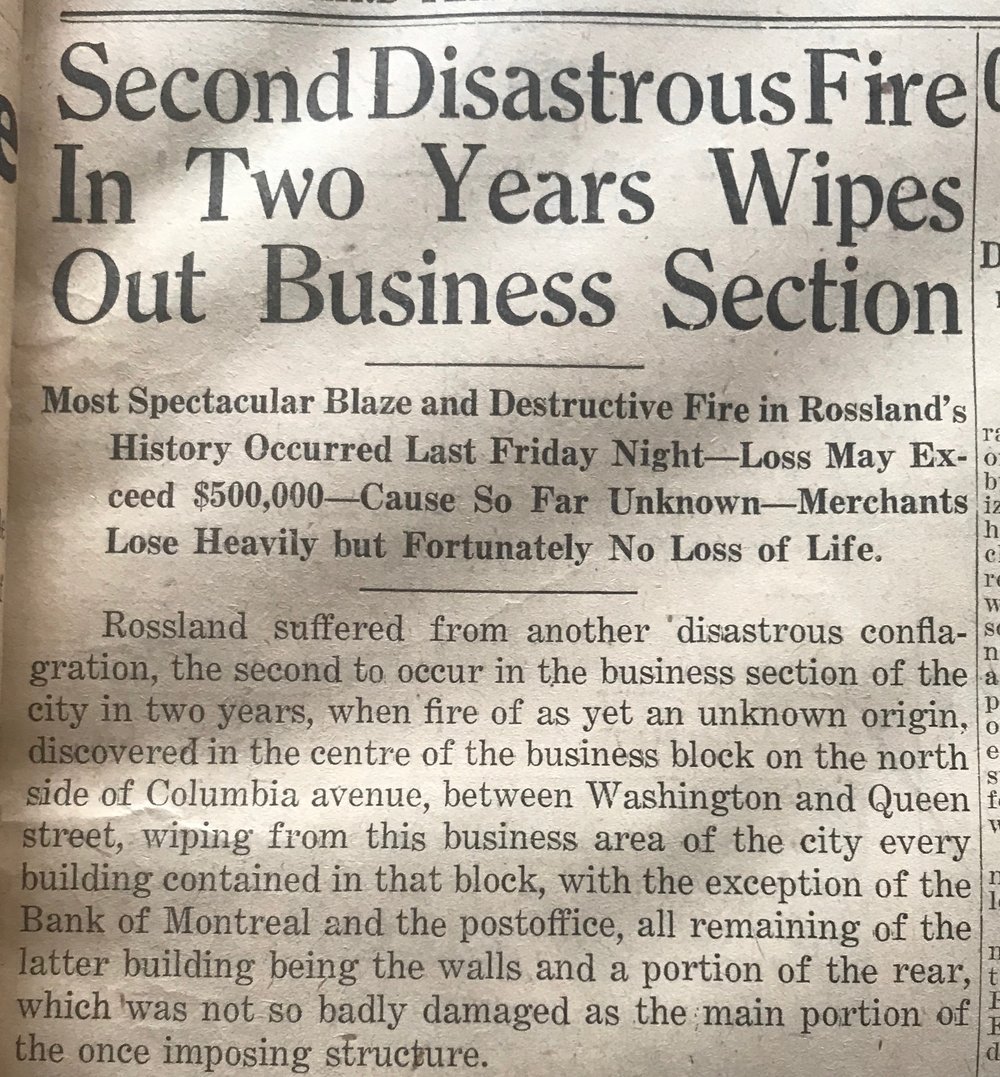Fire Safety in Rossland
Fires were a serious problem for many boomtowns, as the hasty nature in which these communities were assembled meant most buildings were constructed from wood and not necessarily designed with fire safety in mind. In fact, one of the driving factors that led to Rossland’s incorporation was the fire issues the mining camp faced, and thus, the desire for a more organized response to fires. Moreover, pressure for fire safety upgrades in Rossland came from fire insurance companies, who in 1896 pulled all insurance from Rossland homes as they felt fire safety was inadequate - thus further incentivizing that proper safety equipment be bought. In 1896, the Rossland Water & Light Company installed six fire hydrants in Rossland. That same year, a civic-minded citizen - Mr. Lalonde - collected money to purchase 500 feet of fire hose and two hose nozzles for the camp, yet even more was soon invested in more equipment, as fire insurance companies remained unsatisfied with the quality of safety procedures and equipment.
With the incorporation of Rossland in 1897, the Rossland Fire Department was founded and began taking control of fire safety. Since its start, the department has relied on volunteer firefighters, and generations of Rosslanders have stepped up to the task. In the early years, people were also willing to lend horses and carts to the department if they were needed. After all, in a town as close-knit as Rossland, fire safety was, and still remains, everyone’s business.
Fires in Rossland
Despite the best efforts of the Fire Department, Rossland has experienced many fires over the years. Within the first half of the 20th century, there were three particularly destructive fires of note.
Headline of the Rossland Miner newspaper’s story on the 1902 fire, published Tuesday August 26th, 1902.
The 1902 Fire
At 3pm on August 25th, 1902, a fire started in local businessman Pat Burns’ store, located on Spokane Street in the downtown hub. Quickly, the fire began to spread to surrounding buildings, and there was widespread panic that the whole town was going to burn down. The Trail Fire Department was called in to help the Rosslanders fight the fire, arriving by a special train service one hour later. By 5pm, the fire had been controlled and extinguished, although substantial damage was done in the north-east of the city. The estimated loss caused by the fire was placed at $75,000 (over $1.7 M in 2019). The devastating fire ironically occured just two years after the implementation of a bylaw that required all new buildings to be constructed of non-combustible material (i.e. not wood). This bylaw led to the construction of two beautiful heritage buildings still standing today: the Glazan Block and the Burns Block.
“The flames mounted 20 feet above the blazing buildings, roaring in the most threatening manner and twisting in a wide radius at the sport of the brisk breeze prevailing”
The 1927 Fire
In the freezing winter of 1927, on the evening of January 21st, a fire broke out on the south side of Columbia Avenue, the heart of downtown Rossland. The fire brigade was quick to the scene but found themselves unable to act as the water pipes were frozen from the cold. The fire raged until it eventually burnt itself out, having destroyed half a block of buildings.
Article from the Rossland Miner, Thursday February 3rd, 1927.
From the article: ‘Fire Marshal to Investigate Recent Fire’ in the Rossland Miner, Thursday, February 3rd, 1927.
“Mr. and Mrs. Ledoux who resided in the American hotel building, recently acquired by them from Mrs. Matilda Henderson, of Vancouver, were preparing for the evening meal then Mrs. Ledoux detected the odor of smoke and asked her husband to investigate. Mr. Ledoux on arriving in the ground floor of the building found the place filled to a point of suffocation with smoke, the two just barely escaping, Mrs. Ledoux being clothed only in a thin housedress, and wearing slippers, not having any time to spare in saving any of their valuables or clothing”
The 1929 Fire
Just two years after the last dreadful fire, and as if an omen of the hard depression years to come, Rossland faced yet another fire to break out on the north side of Columbia Avenue on March 1st, 1929. Although the pipes were not frozen this time, unexpectedly low water levels left firefighters with very little resources to fight the fire. Ironically, the city had just invested the year before in building a 25-million gallon reservoir, yet low precipitation and snowmelt left it unfilled. This fire was responsible for the destruction of the famous Rossland Club building, a stately clubhouse for the town’s most prestigious social club. Moreover, the fire decimated the buildings between the Bank of Montreal and the Post Office.
“Dynamite was brought into play on some buildings doomed to go, but this appeared only to add fuel for the flames, it being believed that the post office, through the windows being broken by the blasts, possible suffering destruction where it might have been saved had what water was available been entered upon it.”
“The only near danger of loss of life was when the three small children of Dr. And Mrs. E. E. Topliff were rescued in the nick of time, the tots being asleep when the fire leaped to the McDonell and Costello building.”
The Silver Lining
Although these fires left a dark mark on the city of Rossland, they did lead to important advancements in the city’s fire safety. After the 1927 and 1929 fires, insulation was installed along the hydrants and water pipes and great energy was invested into maximizing the efficiency of tactics used.
“The ‘Old Rossland Spirit’ still prevails, One cannot help but marvel at the spirit of optimism displayed by many who suffered heavy losses after years of business in Rossland, many of those whose places were destroyed being pioneers in the business life of Rossland. In a small group discussing the fire was one of the heaviest losers, and one of the oldest old-timers, who, when sympathy was extended him, was heard to say: ‘What matters, are we not all here?’”
Continue the Outdoor Tour:
Contribute your own memories/experiences of Rossland fires or firefighting:
The form below will email us your message. If you prefer to speak to us directly or have other questions or comments about this page, please call (250) 362-7722 or email the archives directly at archives @rosslandmuseum.ca












